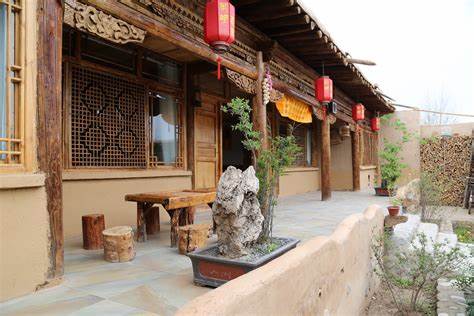Overview
Chinese Name: 土族
English Name: The Tu nationality
Languages: Tu language 土语, Chinese 汉语
Total population: 2.89*105 (China mainland 2022)
Distribution: Mainly live in Huzhu Tu Autonomous County 互助土族自治县

Brief introduction
The Tu nationality 土族 is one of the ethnic groups with a relatively small population in China. The Tu nationality language belongs to the Mongolian language family of the Altai language family 阿尔泰语系. The Tu people mainly live in Huzhu Tu Autonomous County 互助土族自治县, Qinghai.

The history of the Tu nationality
Due to the lack of systematic written records, the folklore of the various Tu ethnic groups is different from each other, and the issue of ethnic origin is still inconclusive. At present, more opinions in academic circles tend to have a lot of connection between the ancestors of the Tu people and the Mongolians.
The religion of the Tu nationality
The Tu people basically believe in Tibetan Buddhism 藏传佛教. At the end of the Yuan Dynasty 元朝 and the beginning of the Ming Dynasty 明朝, Tibetan Buddhism was introduced into the Tu ethnic areas and developed rapidly. In addition, the monastery is the cultural centre of the Tu people and has made important contributions to the development and spread of Buddhist culture.

The Cultures of the Tu nationality
The costumes of the Tu nationality 土族的服饰
The traditional costumes of the Tu people are bright in colour, unique in style, and have strong national characteristics. Traditional men’s clothing, wearing a brocade-trimmed felt hat, an embroidered high-neck slanted white short jacket, a colorful embroidery pattern on the chest, a black, blue or purple waistcoat, or a long robe with wide edges.
In addition, Tu men are also accustomed to inlay four-inch wide red or black trims on the neckline, lapel, cuffs and hem. The women’s clothes were more flamboyant, with colourful round brocade tapestry hats on their heads, long silver ornaments on their ears, fuchsia waistcoats over their robes, and wide and long coloured waistcoats tied around their waists. There are exquisite embroidery on both ends of the belt and the streamer, on which are hung purses with colourful patterns, needle sticks, copper bells and other decorations, and wear skirts and trousers, and shoes with colourful clouds embroidery.

The most distinctive feature of their costumes is the colourful flower sleeves, which are made of red, yellow, green, blue and purple coloured cloth. They proudly said that it was matched with the colours of the rainbow in the sky, and it was particularly eye-catching when they were worn. Compared with young people, the attire of old women is much simpler, they do not wear colourful flower-sleeved shirts, nor do they wear embroidered ribbons.
The diet of the Tu nationality 土族的饮食
The eating habits of the Tu people have a historical process of change. Before the Yuan Dynasty, the Tu people were mainly engaged in animal husbandry, and the food structure was relatively simple, mainly meat and dairy products, and also eat highland barley fried noodles. After the Yuan and Ming Dynasties, the Tu people gradually turned to the agricultural economy, and their diets were mainly highland barley, wheat and potatoes.

In general, the daily staple food of Tu families is highland barley, followed by wheat. The Tu people have less vegetables, mainly including more than 10 kinds of vegetables, such as radish, cabbage, onion, garlic and lettuce. They eat more sauerkraut on weekdays, supplemented with meat, drink milk tea, and eat fried noodles with butter. Every festive festival, the Tu people will cook all kinds of fried food and mutton.
The architecture of the Tu nationality 土族的建筑
The characteristics of Tu ethnic architecture are outstanding. In rural areas, the Tu people generally live together in the form of villages, and they are used to building houses against mountains and rivers. The walls of the houses are high, and there are rooms on two or three sides of the walls, mostly in groups of three, and a few wealthy families have courtyard houses.

The house is a civil structure with a flat and smooth roof, on which grain and grass can be stored. Most of the pillars and doors and windows of the residence are carved or depicted with colourful patterns that symbolize the robustness of cattle and sheep and the abundance of grains, which are bright and beautiful. Each house has a courtyard with livestock shed inside and a toilet, vegetable garden and threshing floor outside the courtyard.
The rituals of the Tu nationality 土族的礼节
The Tu people have a tradition of attaching great importance to etiquette, especially respecting the elders. If you meet an old man you know on the road, you should dismount to greet them. Whenever a guest comes to visit, they first ask the guest to sit on the Kang covered with red wool felt, and then toast a cup of strong Fu tea with green salt.
When entertaining distinguished guests, a “Ximairi” (that is, a fried noodle box with ghee flowers inserted) is placed on the table, a large piece of fat meat is placed on a wooden plate, and a five-inch knife is inserted on it, and a pinch of white wool is tied on the wine jug, which is also the most respectful hospitality of the Tu people to VIPs.